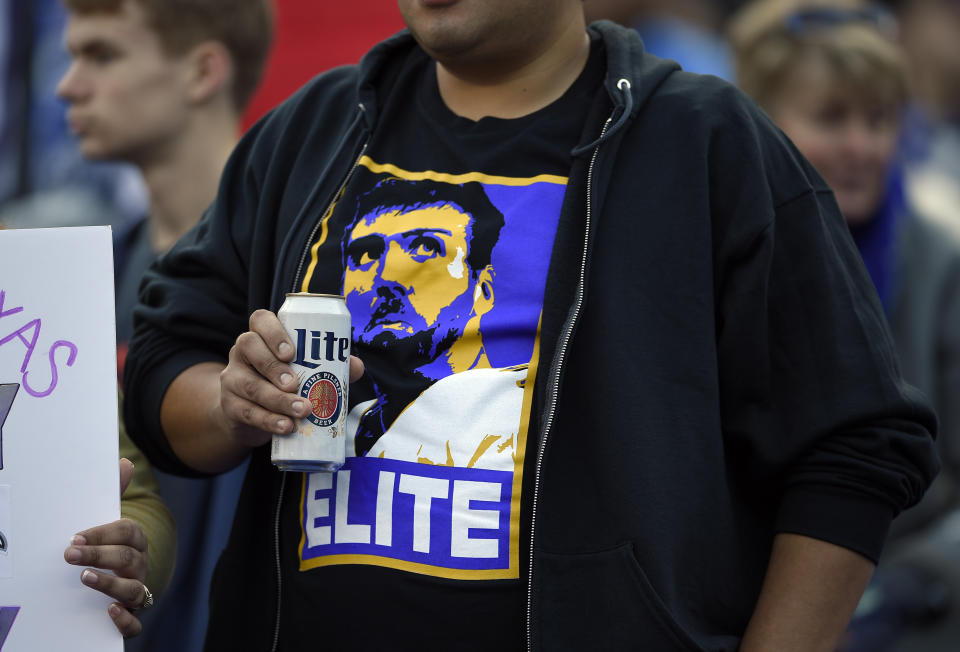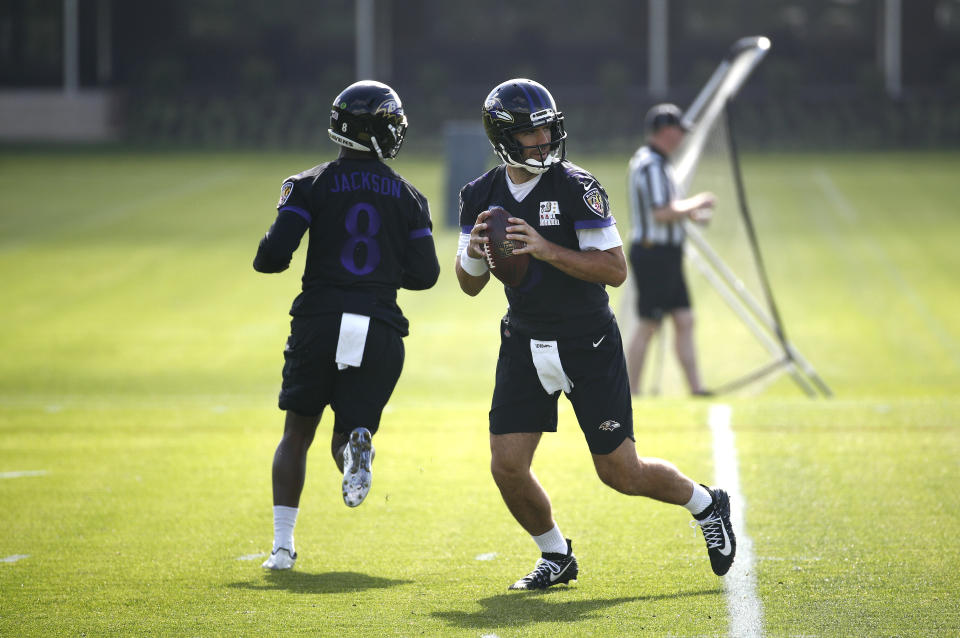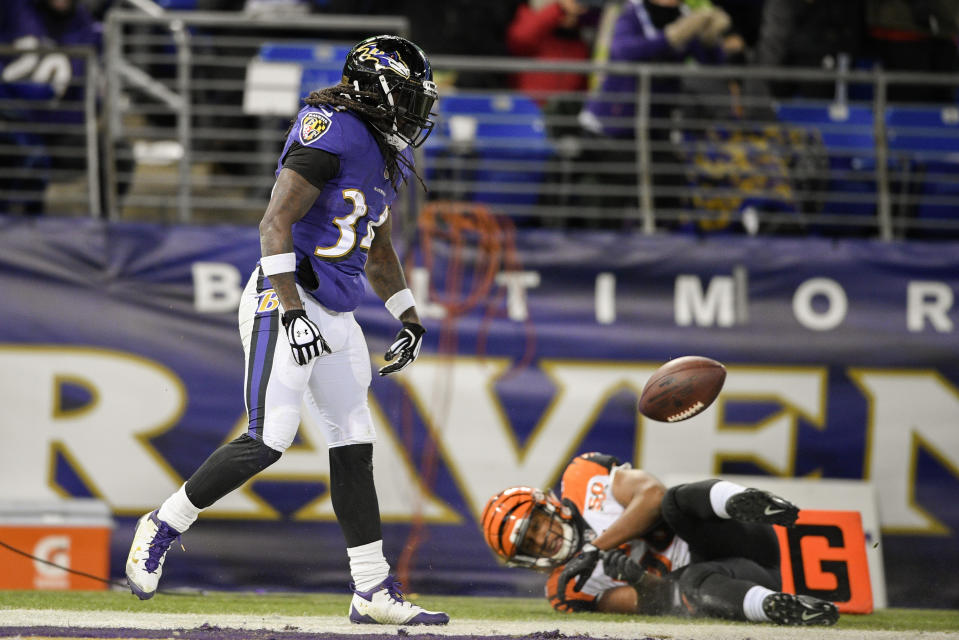Juggernaut Index, No. 29: The last days of Flacco

If, as some believe, the state of U.S.-British relations has worsened in recent months, then we all know who to blame: Joe Flacco.
Flacco’s dreadful performance last season against Jacksonville at Wembley Stadium damaged the reputation of American quarterbacking on an international stage and brought shame to the city of Baltimore. He was breathtakingly bad that day, completing only eight of 18 pass attempts for 28 yards, zero touchdowns and two interceptions. He somehow averaged just 1.56 yards per attempt, the third lowest single-game Y/A ever produced by a QB who attempted 18 or more passes. The game was a coming out party for the Jaguars defense, but it was also the death rattle of Flacco’s eliteness.
[Yahoo Fantasy Football leagues are open: Sign up now for free!]
By the end of the season, Flacco’s numbers were abysmal: 16 games, 3141 yards, 18 TDs, 13 INTs, 5.72 Y/A, 196.3 YPG. He didn’t pass for 300 yards or three TDs in any game, which seems ridiculous in the current era. Tom Savage, Jay Cutler and Mike Glennon all produced 300-yard performances last year. Jacoby Brissett gave us two.
We shouldn’t fail to mention the fact that Flacco’s receiving corps was horrid last season, and the opening week injury to Danny Woodhead was a minor disaster. But there’s no dressing up No. 5’s year as anything other than a flaming wreck. He’s averaged less than 7.0 Y/A in four of the past five seasons. Flacco cannot be drafted in fantasy leagues of standard size and configuration. If you happen to play in an AFC North-only league (which no one does), your top draft day priority should be to avoid Flacco. Even if the man delivers a bounce-back season at age 33, you have to consider the modest level to which he’d be bouncing. He’s never finished as a top-10 fantasy QB. There’s no significant upside here.
The Ravens drafted a dynamic young dual-threat quarterback back in April, so Flacco’s eleventh season in Baltimore might very well be his last.
Lamar Jackson is going to be a fantasy monster
If you were even semi-aware of college football over the past two years, then you’re already well aware of Jackson’s talent. He was a thrilling player at Louisville; his performance last season was in many ways better than his Heisman-winning play in 2016. Jackson possesses rare rushing ability, routinely delivering game-changing plays from both designed runs and scramble situations. He’s a blur. He ran for over 100 yards in 10 of his 13 games last season and reached 300 passing yards six times.
Jackson wasn’t exceptionally accurate at Louisville, but his completion percentage improved each season (59.1 in 2017) and he averaged 8.3 Y/A for his career. He actually had the lowest velocity reading among QBs who threw at the combine (49 mph), yet concerns about arm strength never appear on his scouting reports. His average depth of target was among the highest in his draft class per Pro Football Focus (12.0) and his deep passing stats aren’t discouraging.

Jackson will be a fantasy star the moment he takes the field. He is, right now, the most gifted rushing quarterback in the NFL. (No disrespect intended to Cam Newton.) Jackson demands a full-time defensive spy, which of course creates advantages for his receivers. Even if he’s no better than a mediocre passer when he debuts, he’s a lock to deliver starting-quality fantasy numbers thanks to his his rushing talent. Jackson is the top rookie QB on my board for dynasty purposes, no question.
Flacco’s name is still atop the depth chart for the Ravens, so there’s zero urgency to rush Jackson onto the field. He’ll have time to develop under OC Marty Mornhinweg, a coach who’s worked with some of the most skilled dual-threat quarterbacks in league history, including Mike Vick and Steve Young. Simply put, Jackson landed in a terrific situation in terms of his long-term development. Baltimore is already putting Flacco and Jackson on the field together, searching for ways to get the ball in the rookie’s hands. In Jackson’s best years, he should be something like a combo QB2/RB2. He’s a highlight machine.
Let’s meet the retooled Ravens receiving corps
Mike Wallace, Jeremy Maclin and Benjamin Watson are out; Michael Crabtree, John Brown, Willie Snead and a pair of rookie tight ends are in. This is an astonishing level of turnover, which means it’s probably doomed to failure. Continuity is a big deal in the NFL. Still, it’s hard to blame this team for blowing up the receiving corps, because it was a fantastically unproductive group last season. (Big assist to Flacco.) Wallace’s 748 receiving yards led all Ravens. No player on this team caught more than four TD passes. The best thing we can say about the Ravens’ 2017 passing game is that we’ll never have to see it again.
Crabtree is a clear upgrade over every receiver Baltimore had on the roster last season, and he enters camp as the team’s unrivaled No. 1. He caught 25 TD passes over the past three years in Oakland, twice finishing as a top-20 fantasy wideout. It wouldn’t be much of a shock if he saw 130-140 targets in the season ahead, and, with a workload like that, he’d likely produce WR2-ish numbers. Crabtree figures to be the most reliable member of this receiving corps. At his current ADP (66.6, WR27), he seems like a fair bargain.
Brown is a terrific vertical threat with a 1000-yard season on his resume, but, as most of you know, a sickle-cell condition has limited his availability. When he’s right, he’s a dangerous receiver. It’s tempting to recommend Brown only as a best-ball option, but that’s a bit too dismissive. He’s a very good player when fully functional and he’s pretty much always available in the final round in redraft formats. Brown is far from the worst flier you can take; he was a 65-1003-7 player three years ago, and he’s only 28.
Snead is coming off a value-crushing season, limited by both suspension and injury. Like Brown, he peaked in 2015, working with a better QB than he’ll be dealing with in 2018. Snead will play the slot and function as the third receiving option for a team that isn’t likely to deliver more than two ownable pass-catchers.
Rookie tight end Hayden Hurst seemed like a semi-intriguing fantasy option when Baltimore selected him in the first round, but his appeal quickly dimmed when the team added Oklahoma’s Mark Andrews in Round 3. Andrews caught 62 balls for 958 yards and eight spikes in the Sooners’ Tecmo offense last season, outproducing Hurst by a wide margin (44-559-2). Neither player is likely to achieve fantasy relevance in 2018. Tight end isn’t a spot where we expect rookies to thrive. Dynasty drafters, you want Miami’s Mike Gesicki over both Hurst and Andrews.

Alex Collins is legit
The one positive development for Baltimore in an otherwise awful excursion to London last season was the emergence of Alex Collins at running back. He rushed nine times for 82 yards that day, leapfrogging Terrance West in the team’s backfield hierarchy. Collins was released by the Seahawks at the end of the preseason and signed to the Ravens’ practice squad a week before the opener. He was barely clinging to a spot in the league when Woodhead’s injury and West’s struggles created an opportunity. He would finish the season with 1160 scrimmage yards and six TDs on 235 touches.
Collins ranked second among all NFL backs in breakaway runs last season (16) according to Player Profiler, behind only Kareem Hunt, and he finished ninth in evaded tackles (76). He was pretty damn good. Collins isn’t exceptionally fast by NFL standards, but he was a hard-charging and decisive runner last year, gaining every inch available to him. Baltimore’s offensive line graded well last year, despite the injury-related absence of six-time Pro Bowler Marshal Yanda.
Collins, to me, seems like a relative steal at his draft price (ADP 34.8, RB19). Buck Allen is not a serious threat — he hasn’t averaged more than 3.9 YPC in any season — and Kenneth Dixon is simply fighting for a job. Dixon missed the entire 2017 season due to suspension and knee surgery. Collins is this team’s unchallenged lead back entering camp.
Baltimore’s defense led the NFL in takeaways last season (34) and ranked sixth in points allowed (18.9 PPG), so this D/ST is a draft-worthy fantasy asset. The Ravens will open the season with a home matchup against Buffalo and then a road game at Cincy, giving this D extra appeal. Linebacker C.J. Mosley delivered a career-high 132 tackles last year, so he remains an upper-tier IDP.
2017 Offensive Stats & Ranks
Points per game – 24.7 (ninth in NFL)
Pass YPG – 189.4 (29)
Rush YPG – 116.0 (11)
Yards per play – 4.6 (31)
Plays per game – 65.9 (9)
Previous Juggernaut Index entries: 32) Buffalo, 31) Miami, 30) NY Jets, 29) Baltimore
Follow the Yahoo fantasy football crew on Twitter: Andy Behrens, Dalton Del Don, Brad Evans, Liz Loza, Scott Pianowski and Tank Williams


